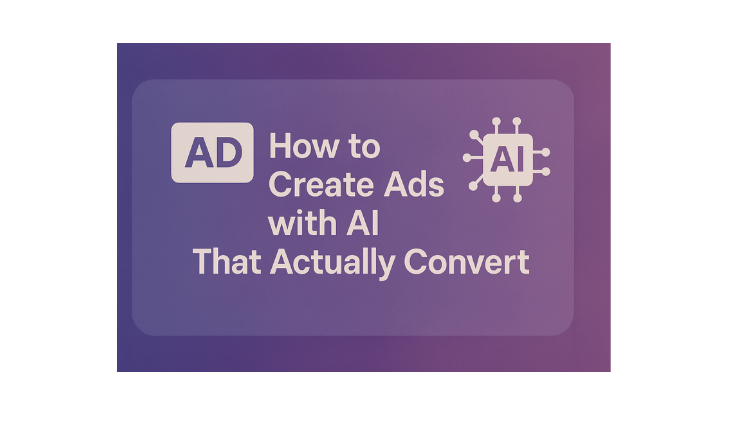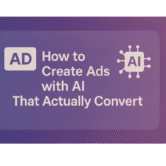
How to Create Ads with AI That Actually Convert
Introduction
In today’s fast-paced digital marketing landscape, artificial intelligence (AI) has revolutionized how businesses create and optimize advertising campaigns. While AI offers unprecedented efficiency and scalability, many marketers struggle to generate ads that actually drive conversions. The promise of AI-powered advertising is enticing—create more ads faster, target more precisely, and optimize continuously—but without the right approach, these technological advantages can fall flat.
This guide explores proven strategies for creating AI-generated ads that not only look professional but actually convert prospects into customers. We’ll dive into practical techniques, common pitfalls to avoid, and how to maintain the human touch that resonates with your audience even when leveraging cutting-edge AI tools.“AI-powered ads can save time and improve ROI. If you need expert help in creating high-converting campaigns, Help Me Buddy IT Pvt Ltd offers professional digital marketing solutions.”
Understanding AI’s Role in Modern Advertising
The Current State of AI in Advertising
AI has transformed advertising in several key areas:
- Content generation: Creating ad copy, images, and even video
- Audience targeting: Identifying and segmenting potential customers
- Performance prediction: Estimating which ads will perform best
- Dynamic optimization: Real-time adjustments based on performance data
Despite these capabilities, many AI-generated ads underperform because they lack strategic implementation and human oversight. The tools themselves aren’t magic—they’re instruments that require skilled operators.
Why Most AI-Generated Ads Fall Short
Before diving into best practices, it’s important to understand why many AI-generated ads fail to convert:
- Generic messaging that doesn’t speak to specific customer pain points
- Missing emotional triggers that drive human decision-making
- Poor integration with broader marketing strategies and brand voice
- Over-optimization for clicks rather than conversions
The most successful marketers view AI as an amplifier of human creativity and strategy, not a replacement for it.
7 Steps to Create High-Converting AI Ads
- Start with Clear Campaign Objectives
Before asking AI to generate anything, define what success looks like:
- What specific action do you want users to take?
- What metrics will you use to measure success?
- What is your target cost-per-acquisition?
AI tools perform best when given clear parameters and goals. For example, instead of asking AI to “create a good Facebook ad,” specify that you need “a Facebook carousel ad targeting small business owners that drives webinar registrations with a focus on solving time management challenges.”
- Feed Your AI Quality Data
Your AI outputs are only as good as your inputs. Provide:
- High-performing ad examples from your previous campaigns
- Customer testimonials and voice-of-customer data
- Competitor analysis highlighting effective messaging
- Target audience profiles with detailed psychographics
Many marketers make the mistake of providing minimal information to their AI tools and then wonder why the results feel generic. The more relevant, high-quality data you input, the more tailored and effective your ads will be.
- Master Prompt Engineering for Advertising
Effective prompting is perhaps the most critical skill for working with generative AI tools:
- Be specific about the target audience: “Create an ad for busy professional women, ages 35-45, who struggle with work-life balance and need quick, healthy meal solutions.”
- Include brand voice guidelines: “Our brand voice is confident but not arrogant, professional but warm, and uses simple language without talking down to customers.”
- Request multiple variations: “Generate 5 different headline approaches focusing on time savings, quality, convenience, health benefits, and family enjoyment.”
- Specify structural elements: “Include a clear pain point in the first sentence, introduce our solution in the second sentence, and end with a benefit-driven call to action.”
- Maintain Brand Consistency Across AI-Generated Content
Even the best AI tools can drift from your brand identity without proper guidance:
- Create a detailed brand style guide for AI prompting
- Develop templates with fixed brand elements and variable content areas
- Implement a review process to ensure brand consistency
- Use fine-tuned AI models trained on your specific brand voice when possible
Consistent branding builds trust, and trust drives conversions. This is especially important when scaling ad creation with AI.
- Add the Human Element That Drives Conversions
The most effective ads connect emotionally, something AI still struggles with on its own:
- Inject authentic storytelling into AI-generated frameworks
- Incorporate customer language from reviews and support interactions
- Address specific objections your sales team commonly encounters
- Include social proof elements strategically
One effective approach is to use AI to generate the structural foundation of your ads, then have human copywriters enhance the emotional appeal and authenticity.
- Implement A/B Testing at Scale
AI excels at creating variations for testing:
- Test different value propositions to identify what resonates most
- Compare emotional vs. logical appeals with your specific audience
- Experiment with various visual styles while maintaining brand guidelines
- Test different AI tools against each other to find what works for your brand
The key is not just running tests but establishing a systematic process for implementing learnings across your advertising ecosystem.
- Use AI for Continuous Optimization
Converting ads rarely emerge perfectly on the first try:
- Set up automated performance monitoring with clear thresholds for intervention
- Use AI analysis tools to identify patterns in high-performing ad elements
- Retrain your models with new data from successful campaigns
- Build feedback loops where conversion data informs future ad creation
Common Pitfalls to Avoid with AI-Generated Ads
Over-Reliance on AI without Strategic Direction
Many marketers treat AI as a magical solution that will automatically create high-converting ads. This approach typically leads to generic, ineffective advertising. Instead, view AI as a powerful tool within your strategic framework.
Forgetting Your Unique Selling Proposition
AI tends to generate “safe” content that can resemble what everyone else is doing. Always ensure your unique value proposition shines through in your prompts and final ad creative.
Neglecting Compliance and Regulation
Different industries and platforms have specific advertising regulations. AI might not be aware of the latest guidelines for your particular situation. Always review AI-generated content for compliance with:
- Industry-specific regulations (finance, healthcare, etc.)
- Platform policies (Google, Facebook, etc.)
- Truth-in-advertising requirements
- Data privacy implications
Chasing Trends at the Expense of Results
Just because AI can easily generate trendy ad formats doesn’t mean they’re right for your audience. Focus on what converts rather than what’s cool at the moment.
Tools and Platforms to Enhance Your AI Ad Creation
Content Generation Tools
- Copy AI and Jasper for ad copy variations
- DALL-E and Midjourney for custom ad imagery
- Synthesia and Opus Clip for video ad creation
Testing and Optimization Platforms
- VWO and Optimizely for structured A/B testing
- Hotjar for understanding user behavior
- Pattern89 for AI-powered ad insights
Integration and Workflow Solutions
- Zapier for connecting your AI tools to advertising platforms
- Airtable for organizing AI-generated content and performance data
- Notion for collaborative workflows around AI advertising
Case Study: How Company X Improved Conversion Rates by 137% Using AI Ads
[Include a brief case study here about a company that successfully implemented these strategies. If you don’t have a specific case study, you can create a hypothetical example based on realistic scenarios.]
“AI ads are powerful, but professional execution makes all the difference. Contact Help Me Buddy IT Pvt Ltd today to create ads that truly convert.”
Measuring Success: KPIs for AI-Generated Advertising
Beyond standard metrics like CTR and CPC, consider these KPIs specifically for AI-powered advertising campaigns:
- Prompt-to-performance ratio: How efficient are your prompts at generating high-performing ads?
- Creative velocity: How has AI impacted your team’s ability to produce and test new creative?
- Audience discovery efficiency: How effectively is AI helping identify new profitable audience segments?
- Optimization cycle time: How quickly can you implement and verify improvements?













